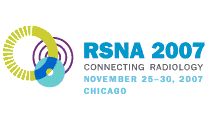
Abstract Archives of the RSNA, 2007
SSA15-02
Effect of CAD on Radiologists’ Detection of Lung Nodules on Thoracic CT Scans: Analysis of an Observer Performance Study by Nodule Size
Scientific Papers
Presented on November 25, 2007
Presented as part of SSA15: Physics (Thoracic CAD )
Berkman Sahiner PhD, Presenter: Nothing to Disclose
Heang-Ping Chan PhD, Abstract Co-Author: Nothing to Disclose
Philip Neil Cascade MD, Abstract Co-Author: Nothing to Disclose
Ella A. Kazerooni MD, Abstract Co-Author: Consultant, General Electric Company
Consultant, Vital Images, Inc
Aamer Rasheed Chughtai MBBS, Abstract Co-Author: Nothing to Disclose
Chad Poopat MD, Abstract Co-Author: Nothing to Disclose
Lubomir M. Hadjiiski PhD, Abstract Co-Author: Nothing to Disclose
Thomas Kieju Song MD, Abstract Co-Author: Nothing to Disclose
Luba Frank MD, Abstract Co-Author: Nothing to Disclose
Jadranka Stojanovska MD, Abstract Co-Author: Nothing to Disclose
Anil Kumar Attili MBBS, Abstract Co-Author: Nothing to Disclose
et al, Abstract Co-Author: Nothing to Disclose
et al, Abstract Co-Author: Nothing to Disclose
To evaluate the impact of nodule size on the effectivess of CAD for lung nodule detection on thoracic CT scans.
We developed a CAD system for lung nodule detection on CT scans. For the observer study, an independent test set of 85 CT scans was used (52 from the Lung Imaging Database Consortium, and 33 from patient files at our institution with IRB approval). All scans were read by multiple expert thoracic radiologists, who identified a total of 122 nodules as the reference standard of truth. A true location was defined as a region marked by at least one radiologist as containing a nodule. Six other thoracic radiologists read the CT scans first without, and then with CAD. They marked suspected nodules and gave a confidence rating on each. The performance of the study radiologists was evaluated using FROC and JAFROC analyses for different threshold nodule sizes. The nodule size was defined as the largest axial diameter, averaged over all expert radiologists who detected the nodule. Nodules ranged in size from 3.0 to 88.8 mm (median=5.7 mm).
The CAD system had a sensitivity of 77% (94/122), 78% (74/95), 79% (61/77) and 79% (44/56) for detecting nodules larger than 3, 4, 5 and 6 mm, respectively, with 5.5 FP marks per nodule-free scan. When the study radiologists read the cases without CAD, JAFROC analysis obtained average figures of merit (FOMs) of 0.81, 083, 0.86, and 0.87 for nodule sizes above these thresholds, respectively. With CAD, the corresponding average FOMs improved to 0.85, 0.86, 0.88 and 0.89, respectively. The improvement was statistically significant for nodules > 3 and 4 mm (p=0.007 and 0.03, respectively), but did not achieve statistical significance for nodules > 5 and 6 mm (p=0.055 and 0.08, respectively).
Reading with CAD improved the performance of thoracic radiologists for detecting lung nodules. The improvement was significant for nodule size thresholds of > 3 and 4 mm, but not significant for nodule size thresholds of > 5 or 6 mm.
Analysis of the effect of CAD provides information that may impact feasibility of lung cancer screening with CT. CAD can improve detection of small lung nodules with potential clinical significance.
Sahiner, B,
Chan, H,
Cascade, P,
Kazerooni, E,
Chughtai, A,
Poopat, C,
Hadjiiski, L,
Song, T,
Frank, L,
Stojanovska, J,
Attili, A,
et al, ,
et al, ,
Effect of CAD on Radiologists’ Detection of Lung Nodules on Thoracic CT Scans: Analysis of an Observer Performance Study by Nodule Size. Radiological Society of North America 2007 Scientific Assembly and Annual Meeting, November 25 - November 30, 2007 ,Chicago IL.
http://archive.rsna.org/2007/5003019.html

